27th Mar 2024 | News & Events
Triennial NGV Excursion- Art Extend Year 9 & 10
For our excursion, we went to the NGV on Tuesday 12th of March to see the Triennial exhibition at the NGV. We took the train both there and back and during our time in the Gallery, we went to and saw multiple amazing paintings, including sculptures, clothes, furniture, and woodwork. The Triennial is an exhibition that only happens every 3 years. This year’s triennial has 120 artists with 100 works. The triennial takes place throughout the entire gallery and some of the works are put in with permanent works at the NGV. We had to take photographs of 3+ artworks and the description on the wall.
Here are some of the artworks we reviewed:
Artwork 1
I chose the artwork My Mummy is Beautiful by Yoko Ono because I think it’s a powerful and beautiful way to recognise all the things that mothers do for their kids. The artwork started as a written message that invited people who visited the NGV Triennial to write about their mothers and appreciate them. There were pens, pencils, and paper left so people could write and then put it on the walls of the room. I think it’s a very emotional interactive art piece.
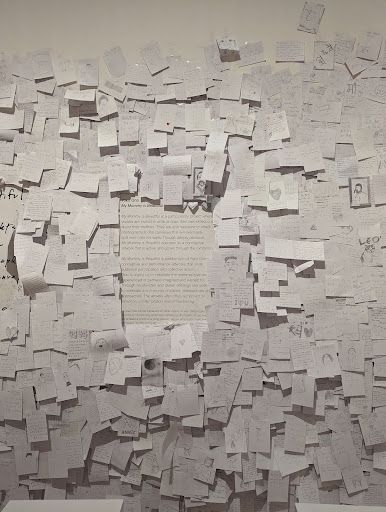
Yoko Ono – My mummy is beautiful
Artwork 2
Mun-Dirra – This weaving was created by Freda Ali Burarra-Martay, Freda Wayartja Ali Burarra-Martay, Maureen Ali Burarra-Martay, Cecille Baker Burarra-Martay, Michelle Baker Burarra, Bonnie Burarngarra Burarra/Yan-nhaŋu, Gabriella Garrimara Burarra-Martay, Doreen Jinggarrabarra Burarra Anbarra, Lorna Jin-gubarrangunyja Burarra-Martay, Indra Prudence Burarra-Martay, Jennifer Prudence Burarra-Martay, Zoe Prudence Burarra-Martay and Anthea Stewart Burarra-Martay.
Mun-dirra was the Maningrida Fish Fence and took 2 years to create and is a multi-panel, 100 meter, woven artwork. It is woven with natural materials like gun-menama (pandanus leaves), burdaga (kurrajong), and various bark fibres, resulting in its varying umber, sepia yellow, apricot orange, burnt orange, and merigold colouration.
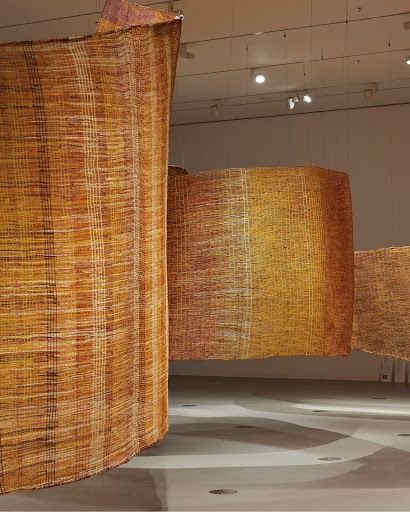
Mun-dirra weaving
This artwork intrigued me for many reasons. When I walked through the labyrinth of woven fences I lost my direction, steered by the curves of the walls. It was almost as if I were a fish, lost and immersed in these intricate colours and patterns. I was absorbed by its symbolism of the complexity and interconnectedness of the human soul. Each fibre of thought, each aspect of our being, woven together to create structures and shapes that you could get lost in unravelling. I was drawn to the curved, flowing shapes of the panels that made the journey continuous, and the warm, earth-tone colours that made the art feel natural and welcoming. Walking through the paths these fences guided me was immersive and encouraged conflicting senses of self-guided direction and disorientation.
Artwork 3
A project that particularly stood out was “Designs for a World of Many Worlds: After the Festival”, a collection of sculptures on Level 3 of the NGV. The sculptures, or totems, mementos and accessories, were designed by English artists and designers Anthony Dunne and Fiona Raby, or Dunne & Raby design studio. It is a collection of artefacts from a fictional festival celebrating a new point of view. The main idea is that “humanity could come to understand its place in a multi-species reality” and realise the diverse sensory perspectives of the organisms we share environments with.
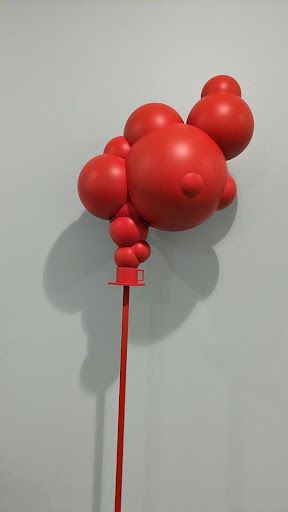
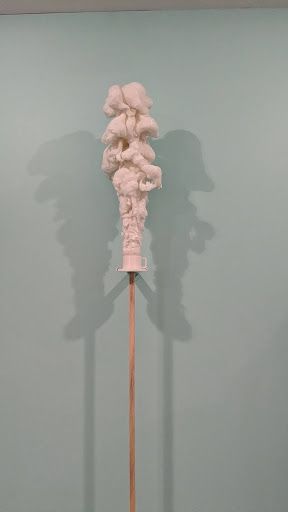
Cup-air 1 and 2
For example Cup-air 1 and 2 are 2 out of 10 pieces from this collection. They show the movement of air, in this case, hot air rising from a teacup. What would typically be a fleeting sight of steam in the air, has been solidified in these Huon pine sculptures. Cup-air 1 (left) uses simplistic, boldly coloured spheres to show the air swelling out of the cup. Cup-air 2 (right) uses finer details and textures to display a more intricate and delicate, yet equally prominent, upward path of air.
Shoes were also one of the designs of the costumes of the fictional festival. Made from felt, they have a rippling effect that extends outward from the centre of the shoes. This conveys the tiny waves of disturbance, or vibrations, that each footstep we take sends out. Again, whilst this impact might seem insignificant to us, it is a visual representation of alternative sensory perspectives – the theme of the festival. The soft fabric could represent that even the softest or gentlest footsteps still have an aftermath.
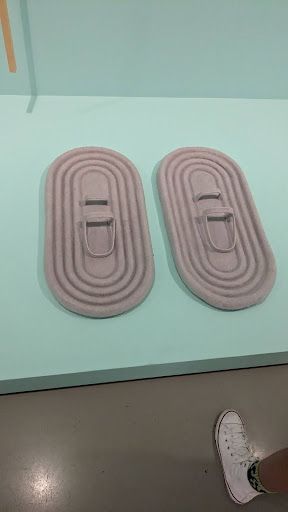
I was drawn to these designs by their unconventional appearance and fascinated by their unique concepts. The pieces are all cohesive under the theme of realising perspectives outside the human experience whilst conveying a diversity of relevant ideas.
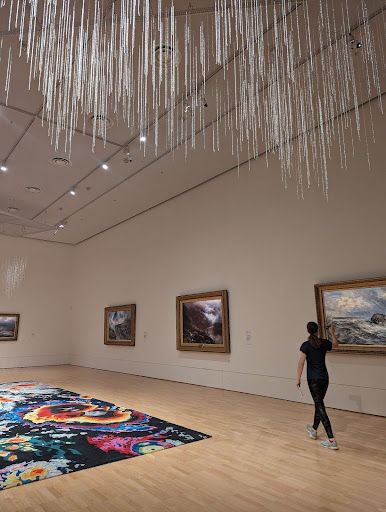

Installation by Franziska Furter -Liquid skies and Haku; Heteroboto by Agnieszka Pilat
We saw many other incredible artworks on display and passed many more that would require another trip (or more) to fully appreciate in as much detail as this one. The diversity of mediums was incredible – from dog-like robots to a heartbeat recording on vinyl to digital art and many more. It was an incredible, immersive experience and I’m very grateful that we were able to go on this excursion.
Art Review by Tessa M, Maicy L, Eleanor F-S, Margaret F-S, Kellyn L, Jacob H and Kenley C.
